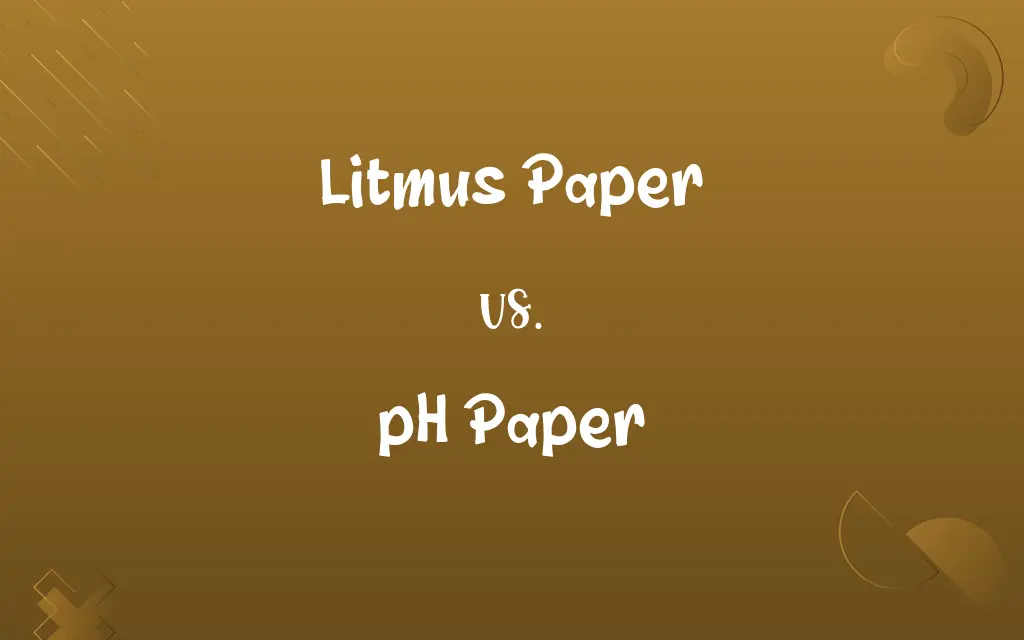Litmus Paper vs. pH Paper: Know the Difference

By Shumaila Saeed || Updated on December 25, 2023
Litmus paper is a simple indicator that shows whether a solution is acidic or basic, while pH paper determines the approximate pH value of a solution.

Key Differences
Litmus Paper is a filter paper treated with a natural water-soluble dye that changes color when exposed to acids and bases. pH Paper is impregnated with a mixture of pH-sensitive dyes, enabling it to measure the pH of a substance within a certain range.
Shumaila Saeed
Dec 22, 2023
Litmus Paper changes to red in acidic conditions and blue in basic conditions, providing a basic acid-base test. In contrast, pH Paper changes to a variety of colors depending on the pH level, offering a more precise pH value.
Shumaila Saeed
Dec 22, 2023
Litmus Paper is often used in education and simple experiments due to its straightforward color change. Meanwhile, pH Paper is used in laboratories, pools, and soil testing for more accurate pH measurement.
Shumaila Saeed
Dec 22, 2023
The simplicity of Litmus Paper makes it less accurate than pH Paper, which provides a broader range of pH detection from highly acidic to highly basic solutions.
Shumaila Saeed
Dec 22, 2023
Litmus Paper is less sensitive compared to pH Paper, as it can only distinguish between acidic and basic solutions, not the strength of the acidity or alkalinity.
Shumaila Saeed
Dec 22, 2023
ADVERTISEMENT
Comparison Chart
Color Change
Red in acid, blue in base.
Multiple colors indicating specific pH levels.
Shumaila Saeed
Dec 22, 2023
Accuracy
Less accurate, only indicates acid or base.
More accurate, shows pH range.
Shumaila Saeed
Dec 22, 2023
Sensitivity
Less sensitive, no specific pH value.
More sensitive, provides approximate pH value.
Shumaila Saeed
Dec 22, 2023
ADVERTISEMENT
Litmus Paper and pH Paper Definitions
Litmus Paper
Used in educational settings for demonstrating acid-base reactions.
Students observed the litmus paper changing color when exposed to vinegar.
Shumaila Saeed
Dec 14, 2023
pH Paper
A laboratory tool for more precise pH measurement.
In the lab experiment, pH paper was essential for accurate pH readings.
Shumaila Saeed
Dec 14, 2023
Litmus Paper
A tool to identify acidic or basic substances.
She dipped the litmus paper into the solution, and it turned red, indicating acidity.
Shumaila Saeed
Dec 14, 2023
pH Paper
Suitable for testing the acidity or alkalinity in various solutions.
He used pH paper to test the soil's pH for gardening purposes.
Shumaila Saeed
Dec 14, 2023
Litmus Paper
A basic chemical testing paper that changes color.
The litmus paper turned blue, showing that the substance was a base.
Shumaila Saeed
Dec 14, 2023
ADVERTISEMENT
pH Paper
A paper used to measure the pH level of a solution.
Using pH paper, she determined that the pH of the pool water was slightly alkaline.
Shumaila Saeed
Dec 14, 2023
Litmus Paper
A straightforward indicator of acidity or alkalinity.
To quickly check the pH, he used litmus paper which turned red in the acidic environment.
Shumaila Saeed
Dec 14, 2023
pH Paper
An indicator that shows a range of pH values through color changes.
The pH paper turned green, indicating a pH of around 7.
Shumaila Saeed
Dec 14, 2023
Litmus Paper
Paper treated with a natural dye for simple pH testing.
In our experiment, we used litmus paper to test if the liquid was basic.
Shumaila Saeed
Dec 14, 2023
pH Paper
Provides a colorimetric pH scale for determining specific pH levels.
The pH paper turned orange, suggesting a pH value of 4.
Shumaila Saeed
Dec 14, 2023
Repeatedly Asked Queries
Can pH Paper provide exact pH values?
It gives an approximate pH value, but not as precise as a pH meter.
Shumaila Saeed
Dec 22, 2023
What is pH Paper?
A testing paper that changes color to show the pH level of a solution.
Shumaila Saeed
Dec 22, 2023
How accurate is Litmus Paper?
It only indicates whether a solution is acidic or basic, not the pH level.
Shumaila Saeed
Dec 22, 2023
Is Litmus Paper suitable for lab experiments?
It's good for simple demonstrations but not for detailed pH analysis.
Shumaila Saeed
Dec 22, 2023
What colors does pH Paper show?
It displays a range of colors, each corresponding to different pH levels.
Shumaila Saeed
Dec 22, 2023
Can Litmus Paper identify neutral solutions?
It doesn't change color in neutral solutions, staying purple.
Shumaila Saeed
Dec 22, 2023
Are there digital alternatives to pH Paper?
Yes, digital pH meters provide more precise readings.
Shumaila Saeed
Dec 22, 2023
What is Litmus Paper?
A basic tool that changes color to indicate if a solution is acidic or basic.
Shumaila Saeed
Dec 22, 2023
Can pH Paper test the pH of oils?
No, it's designed for aqueous (water-based) solutions.
Shumaila Saeed
Dec 22, 2023
Is Litmus Paper safe to use?
Yes, it's safe for educational and simple testing purposes.
Shumaila Saeed
Dec 22, 2023
How many types of pH Papers are there?
There are various types, each with a different pH range sensitivity.
Shumaila Saeed
Dec 22, 2023
How do you read pH Paper?
Compare the color change to a pH scale chart provided with the paper.
Shumaila Saeed
Dec 22, 2023
Can Litmus Paper be affected by other chemicals?
Yes, strong oxidizers or reducers can affect its color change.
Shumaila Saeed
Dec 22, 2023
What industries use pH Paper?
It's used in laboratories, agriculture, pool maintenance, and more.
Shumaila Saeed
Dec 22, 2023
What is the pH range detected by pH Paper?
It typically detects pH levels from 1 to 14.
Shumaila Saeed
Dec 22, 2023
How should Litmus Paper be stored?
In a dry, cool place away from sunlight and moisture.
Shumaila Saeed
Dec 22, 2023
Can Litmus Paper determine the strength of an acid or base?
No, it only indicates the presence of an acid or base.
Shumaila Saeed
Dec 22, 2023
Is pH Paper affected by temperature?
Extreme temperatures can affect its accuracy, so it's best used at room temperature.
Shumaila Saeed
Dec 22, 2023
Share this page
Link for your blog / website
HTML
Link to share via messenger
About Author
Written by
Shumaila SaeedShumaila Saeed, an expert content creator with 6 years of experience, specializes in distilling complex topics into easily digestible comparisons, shining a light on the nuances that both inform and educate readers with clarity and accuracy.








































































